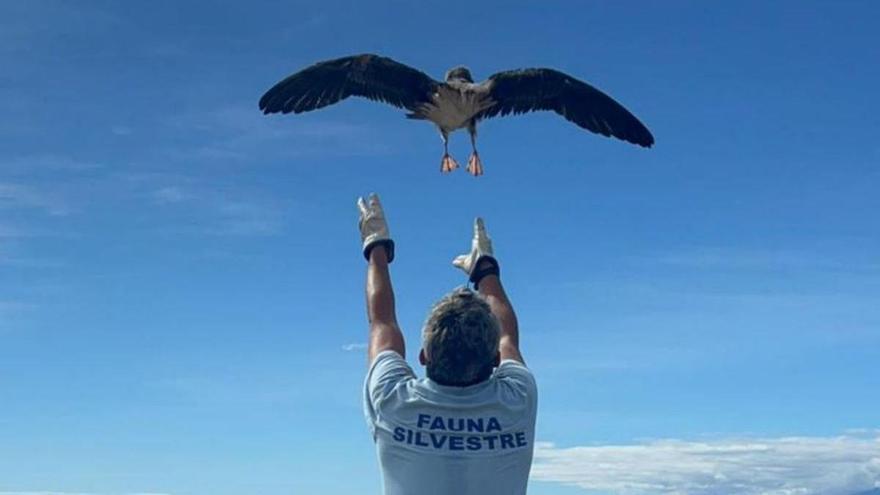
“Guaña guaña”, “guaña guaña”, “guaña, guaña”… This repetitive and distinct sound is familiar to those residing or visiting the coastal areas of Tenerife as night falls. It is produced by Cory’s shearwaters, endangered Atlantic birds that have their breeding season annually from late October to November. Approximately three thousand chicks on average become disoriented during their initial flight toward the sea, often landing in brilliantly illuminated areas. Most are rescued thanks to the efforts of the Cabildo de Tenerife during this time. In 2024, a historical record was achieved with the recovery and successful release of 3,442 specimens.
The initiative was once again executed through the La Tahonilla Wildlife Recovery Centre. Blanca Pérez, the island’s advisor for Natural Environment, Sustainability, and Security and Emergencies, emphasised the public’s awareness and expressed gratitude for the collaboration of all organisations involved in the campaign.
Out of the 3,445 birds rescued during the 2024 campaign, 3,442 were successfully released, marking the highest total since the programme began in 1999.
Blanca Pérez remarked, “We should take pride in the fact that we have managed to rehabilitate nearly all of the rescued specimens.” She added, “I believe that more citizens are becoming engaged and conscious of wildlife preservation, which is a positive development encouraging us to continue pursuing these initiatives.”
The advisor commended the efforts of all parties involved in the campaign, noting the essential role played by citizens, local councils, and volunteers. She highlighted that “in recent years, we have successfully involved tourist establishments as well, which is crucial, considering that many incidents occur in areas plagued by light pollution that causes juvenile shearwater chicks to land prematurely.”
Comparison
During the 2023 campaign, the Cabildo of Tenerife successfully rescued 3,254 Cory’s shearwaters, which is 188 fewer than this year. The programme celebrated its 25th anniversary last year, introducing 35 hotel establishments as part of the initiative known as The First Trip.
The Natural Environment programme, facilitated by the Environmental Participation and Volunteering Office, is coordinated by the La Tahonilla Wildlife Recovery Centre. Its aim is to rescue injured juvenile shearwaters that become disoriented during their first nocturnal flight, attracted by the bright lights near the shore.
Significance
The Atlantic population of Cory’s shearwater (Calonectris diomedea borealis or Calonectris borealis) is listed under the Wild Species with Special Protection Regime and classified as Vulnerable in the Red Book, as well as being included in Annex I of the Birds Directive.
This protected species is one of the largest seabirds in Spain and is recognised as the largest shearwater in Europe. Although migratory, it breeds and spends most of the year along our coast, specifically from February to November.
Due to light pollution, a significant number of juvenile shearwaters, especially on new moon nights, are disoriented and land instead of continuing to the ocean, often unable to take off independently. Some sustain injuries needing treatment at La Tahonilla.
Insights
The campaigns to rescue Cory’s shearwaters in Tenerife not only save thousands of birds annually but also provide crucial data regarding their migratory paths and fidelity to their native colonies. Notably, a bird rescued in Candelaria in 2023 was identified in Cayo Coco (Cuba) in November 2024, demonstrating the movement capabilities and adaptability of this oceanic seabird. Another remarkable example occurred in January 2010 when a bird rescued in Los Cristianos during the 2006 campaign appeared in Mossel Bay (South Africa), confirming the transoceanic range of this species.
Collaborators
The collection campaign for Cory’s shearwaters involves cooperation from all 31 municipalities of the island, local police forces, the Nature Protection Service (Seprona) of the Civil Guard, Civil Protection Groups, Cecopal of Santa Cruz, and the Emergency Coordination Centre and Security (Cecoes).
Furthermore, organisations such as ADAE, AEA, Emergency QRV Canarias, SEO/BirdLife, the Red Cross, Fundación Canarias Recicla, and associations like Inoceana, Save The Planet, Transition Oceans, Terramare, Ecoimplicados, Senda el Bentor, Calima, Excelencia Turística, Amarec, Rumbo Ziday, and Ecan, also contribute, along with the personnel from the Insular Operational Coordination Centre (Cecopin), Natural Spaces Guards, and the insular Office of Environmental Participation and Volunteering.
A distinct sound resonates as night descends in the coastal regions of Tenerife, and may it continue for many years: “Guaña guaña”, “guaña guaña”, “guaña, guaña”…
















